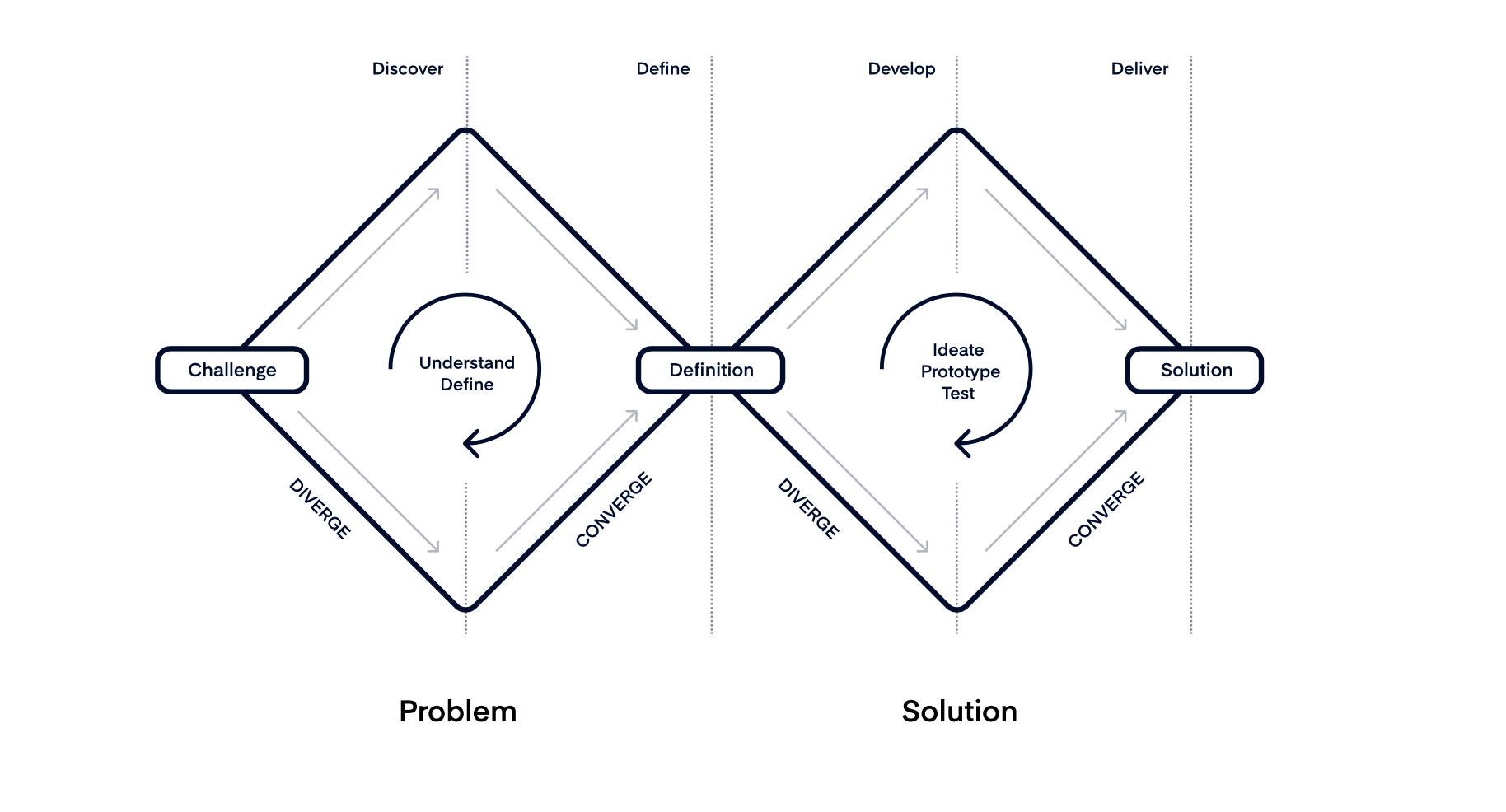The modern product manager’s tech stack

As a product manager, you sit at the focal point of many different parts of your company. You coordinate between R&D functions like design and engineering and go-to-market functions like growth, product marketing, sales, and customer success. And, of course, you need to get buy-in from the executives who (depending on your company) may be very interested in what you do.
The majority of your work as a product manager is to communicate and make sure everyone has a clear idea of what exactly is being worked on and which problem is being solved. You have a responsibility to keep everyone aligned and eliminate surprises.
So which tools will help you achieve this?
It can help to shape your tools and tech stack around the double diamond framework. Keep in mind that this is not always a linear process—some steps may be happening concurrently or loop back on each other.

Understand the problem space
Developing your understanding of the problem space involves building empathy with your users and understanding what the market looks like. To achieve this, you need ways to collect qualitative and quantitative feedback from users.
Tools for capturing qualitative user feedback
For qualitative feedback, like one-on-one user interviews, you need a way of recording and storing the video or audio from these conversations. Tools like Zoom and Chorus.ai work well for this.
As you’re participating in or listening to user interviews, you will also need a place to make note of any key points, action items, or outstanding questions. You might do this in email or Slack or perhaps in a tool like Google Docs or Notion.
To meet customers where they are, try collecting insights from customer-facing tools like Zendesk and Intercom or even directly through your product.
Sales tools like Salesforce can also capture pain points and needs that prospects share with your sales team.
You can see how quickly this can become a huge mess unless you have a place to centralize and organize this information. Productboard is the best repository for collecting customer feedback, organizing it, and mapping it onto the opportunity space. You can use the product hierarchy, add different products or components, and flexible folders to group needs, solutions, and features. This allows you to build out your mental picture of the problem space and users’ needs for the product—and to communicate it clearly.
Tools for capturing quantitative feedback
At some point, you are likely to want to expand beyond one-on-one conversations and collect feedback at a larger scale. Products like FullStory record how people flow through your product. Watching these videos helps you identify trends like where people are dropping off or struggling. Here at Productboard, we find it especially helpful to watch new users onboard so we can see where the biggest points of friction are and where there are opportunities to simplify our product.
There are also tools like Amplitude that help you look at the purely quantitative side of things. If you’ve already built something and want to see what is happening, the product metrics you can uncover through a tool like this are a great way to dive in and understand what’s working well and what’s not.
Surveys are a fantastic way to get a bigger sample size in a more targeted fashion. A tool like SurveyMonkey allows you to do things like measure your NPS score, get a sense of product/market fit, and understand how happy/unhappy people are with your product.
Tools for validating the problem
You’ve listened to your users and you’ve identified some potential problems to target. Now it’s time to validate that you’re heading in the right direction. This often involves communicating your ideas visually. You might do some virtual whiteboarding with Miro. Another tool, Loom, lets you record a screen capture along with audio and this works well to really walk people through what you’re thinking and ensure you’re sharing the same context.

Explore the solution space
Besides understanding your users and the problem space, another key component of product management is exploring the solution space. These steps are more likely to be interwoven than linear, but there are some tools that are especially helpful for the solution-focused part of your work.
Tools for ideating solutions
Creating interactive prototypes can help you better define ideas and processes. It also allows you to test concepts with end-users. Figma is a collaborative tool for building these types of prototypes. With Figma, you can build, validate with customers, and discard ideas much faster than if you spent the time building the whole solution. And because it’s built with internet-first principles, it’s easy to collaborate and sync with designers and engineers—you don’t have to worry about version control since it syncs automatically.
Tools for prioritizing your work
Prioritization is an essential part of product management.
How will you decide which projects and features to move forward with, what sort of timeline to address them in, and how to keep stakeholders in the loop? Productboard is an indispensable tool for all these tasks. You can manage all of the things you could be working on in a single place. You’re able to customize views based on effort, impact, and other scoring mechanisms. This helps you create a shared language so people understand why a specific product or feature was picked. It removes barriers to participation and allows people to self-serve information, removing the burden on busy product managers. You can also include outcomes and objectives in Productboard to see how work connects to these high-level goals.
If you’re looking for a tool that’s specifically designed for managing OKRs, consider something like Ally.io.
Tools for communicating with others
Being a product manager involves a lot of communicating with others. You may need to write out longer narrative documents to describe your strategy in detail.
For this type of task, a tool like Notion or Confluence can be helpful. For shorter team and company updates, you’ll likely rely on PowerPoint or Google Slides for presenting a high-level overview.
And again, Productboard can come in handy because you can customize roadmap views depending on the audience. This allows you to share just the relevant information or timeline and eliminate information that could be confusing or distracting to different people.
Tools for managing tasks or projects
In those times when you need to coordinate cross-functionally, tools like Asana and Trello are helpful for managing a to-do list across different teams. If you’re working with an engineering team that uses Jira, there’s a Productboard integration so you can push data to Jira when you’re ready.
Just remember: Tools can only take you so far
You now have a rundown of the most common tools that make up the modern product manager’s tech stack. But this guide is intended to give you a sense of the landscape—it isn’t meant to be prescriptive. Before jumping on the latest tool, spend some time thinking about what you’re hoping to achieve. Optimize for your goals and then bring a new tool on board. Remember that every tool is only as powerful as the effort that you put into it.





